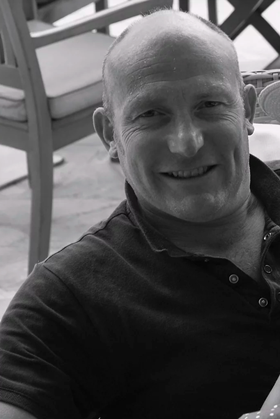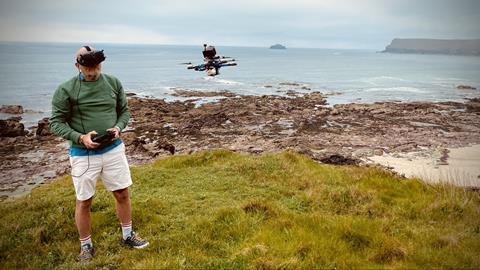This new technique allows the kind of cinematic shots that could not previously have been achieved on a TV budget
The national lockdown of March 2020 pretty much grounded my work as a DoP, as productions were cancelled or mothballed, and I found myself with a lot of time on my hands. Rather than bake banana bread, I took the opportunity to explore an exciting new technology that could change the way we view drones.
I had started to see examples of FPV (fi rst-person view) being used to create incredible sequences with a wholly unique perspective, and was immediately struck by the potential for using this technique on all sorts of film and TV productions.
All I had to do was build a quad drone and learn to fly – easier said than done. So I dusted o my soldering skills and got to work. With golf courses closed to golfers but open to the public for our one hour a day of outside time, I spent the spring learning to fly.
As a DoP, I instantly realised the potential of this new camera platform. FPV is very different to the traditional drones I had been flying professionally for many years. This is freestyle flying, requiring super-fast responsive inputs from the pilot, using the video feed between the camera on the quad and your goggles.
This puts you effectively in the aircraft, hence the term ‘first-person view’. It is this close connection between you and the quad that allows you to fly very accurately, extremely close to people or objects and through tiny spaces – and it’s this precision that allows FPV to add a new dimension to any sequence.
Footage is acquired using different ‘action’ style cams at up to 5K, and with lots of slo-mo options. I can also put a 4K camera in the air, shooting anamorphic, which gives a real cinematic edge.
“The results can be slow and intimate or energetic and dynamic, and would otherwise be impossible without employing heavy CGI in post or a huge crew”
The technology has been adapted from the fast and furious world of drone racing. Once you gain the necessary skills, you can fl y through tiny gaps for amazing reveal shots, or (with larger set-ups) chase cars or boats at great speed while looping around the subject.
The results can be slow and intimate or energetic and dynamic, and would otherwise be impossible to achieve without employing heavy CGI in post or a huge crew. FPV makes cinema-style shooting accessible on TV budgets. I’ve shot a range of shows over the years – from drama to feature docs, food and adventure travel shows – and there is definitely a place in any of these for FPV.

I have used FPV on the BBC3 drama doc High and ITV doc The Queen And Her Cousins, and my latest build will soon be chasing boats around the Cornish coast for a title sequence for a C4 series. I’m also shooting the latest series of Love Your Garden for ITV, using my small ‘cinewoop’ quad to get lovely smooth fly-throughs of the gardens.
There is often a lag between new technology and take-up in the industry, but as more producers and directors become aware of the potential of FPV, I can see it quickly becoming a requirement across the board – from feature films to documentaries, lifestyle to sports, and everything in between.
- Rupert Binsley (https://www.rupertbinsley.co.uk) is a DoP and drone operator. His FPV reel is available at vimeo.com/708561350






























No comments yet